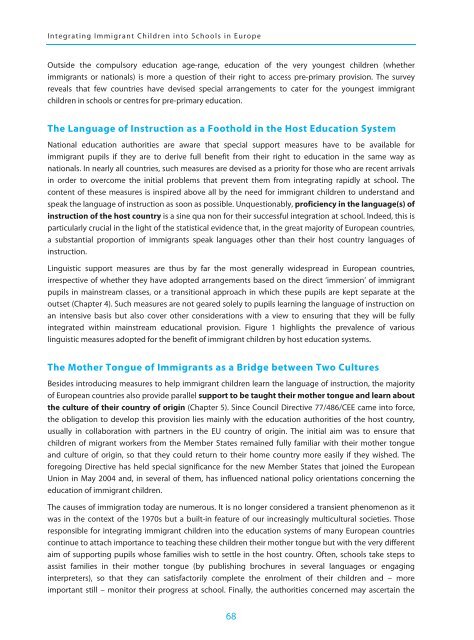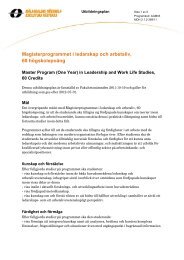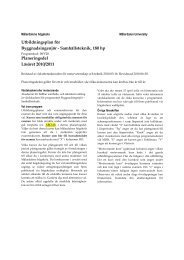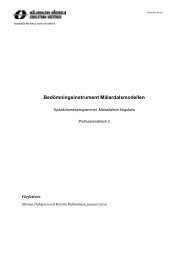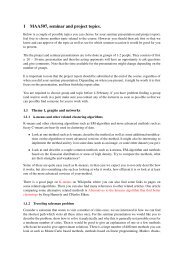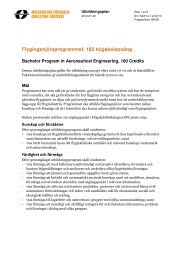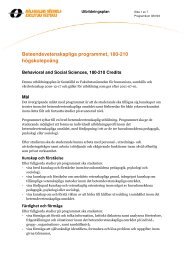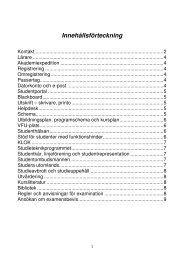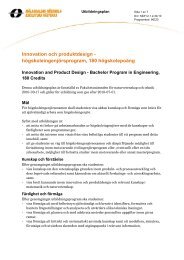Integrating Immigrant Children into Schools in Europe
Integrating Immigrant Children into Schools in Europe
Integrating Immigrant Children into Schools in Europe
You also want an ePaper? Increase the reach of your titles
YUMPU automatically turns print PDFs into web optimized ePapers that Google loves.
<strong>Integrat<strong>in</strong>g</strong> <strong>Immigrant</strong> <strong>Children</strong> <strong><strong>in</strong>to</strong> <strong>Schools</strong> <strong>in</strong> <strong>Europe</strong>Outside the compulsory education age-range, education of the very youngest children (whetherimmigrants or nationals) is more a question of their right to access pre-primary provision. The surveyreveals that few countries have devised special arrangements to cater for the youngest immigrantchildren <strong>in</strong> schools or centres for pre-primary education.The Language of Instruction as a Foothold <strong>in</strong> the Host Education SystemNational education authorities are aware that special support measures have to be available forimmigrant pupils if they are to derive full benefit from their right to education <strong>in</strong> the same way asnationals. In nearly all countries, such measures are devised as a priority for those who are recent arrivals<strong>in</strong> order to overcome the <strong>in</strong>itial problems that prevent them from <strong>in</strong>tegrat<strong>in</strong>g rapidly at school. Thecontent of these measures is <strong>in</strong>spired above all by the need for immigrant children to understand andspeak the language of <strong>in</strong>struction as soon as possible. Unquestionably, proficiency <strong>in</strong> the language(s) of<strong>in</strong>struction of the host country is a s<strong>in</strong>e qua non for their successful <strong>in</strong>tegration at school. Indeed, this isparticularly crucial <strong>in</strong> the light of the statistical evidence that, <strong>in</strong> the great majority of <strong>Europe</strong>an countries,a substantial proportion of immigrants speak languages other than their host country languages of<strong>in</strong>struction.L<strong>in</strong>guistic support measures are thus by far the most generally widespread <strong>in</strong> <strong>Europe</strong>an countries,irrespective of whether they have adopted arrangements based on the direct ‘immersion’ of immigrantpupils <strong>in</strong> ma<strong>in</strong>stream classes, or a transitional approach <strong>in</strong> which these pupils are kept separate at theoutset (Chapter 4). Such measures are not geared solely to pupils learn<strong>in</strong>g the language of <strong>in</strong>struction onan <strong>in</strong>tensive basis but also cover other considerations with a view to ensur<strong>in</strong>g that they will be fully<strong>in</strong>tegrated with<strong>in</strong> ma<strong>in</strong>stream educational provision. Figure 1 highlights the prevalence of variousl<strong>in</strong>guistic measures adopted for the benefit of immigrant children by host education systems.The Mother Tongue of <strong>Immigrant</strong>s as a Bridge between Two CulturesBesides <strong>in</strong>troduc<strong>in</strong>g measures to help immigrant children learn the language of <strong>in</strong>struction, the majorityof <strong>Europe</strong>an countries also provide parallel support to be taught their mother tongue and learn aboutthe culture of their country of orig<strong>in</strong> (Chapter 5). S<strong>in</strong>ce Council Directive 77/486/CEE came <strong><strong>in</strong>to</strong> force,the obligation to develop this provision lies ma<strong>in</strong>ly with the education authorities of the host country,usually <strong>in</strong> collaboration with partners <strong>in</strong> the EU country of orig<strong>in</strong>. The <strong>in</strong>itial aim was to ensure thatchildren of migrant workers from the Member States rema<strong>in</strong>ed fully familiar with their mother tongueand culture of orig<strong>in</strong>, so that they could return to their home country more easily if they wished. Theforego<strong>in</strong>g Directive has held special significance for the new Member States that jo<strong>in</strong>ed the <strong>Europe</strong>anUnion <strong>in</strong> May 2004 and, <strong>in</strong> several of them, has <strong>in</strong>fluenced national policy orientations concern<strong>in</strong>g theeducation of immigrant children.The causes of immigration today are numerous. It is no longer considered a transient phenomenon as itwas <strong>in</strong> the context of the 1970s but a built-<strong>in</strong> feature of our <strong>in</strong>creas<strong>in</strong>gly multicultural societies. Thoseresponsible for <strong>in</strong>tegrat<strong>in</strong>g immigrant children <strong><strong>in</strong>to</strong> the education systems of many <strong>Europe</strong>an countriescont<strong>in</strong>ue to attach importance to teach<strong>in</strong>g these children their mother tongue but with the very differentaim of support<strong>in</strong>g pupils whose families wish to settle <strong>in</strong> the host country. Often, schools take steps toassist families <strong>in</strong> their mother tongue (by publish<strong>in</strong>g brochures <strong>in</strong> several languages or engag<strong>in</strong>g<strong>in</strong>terpreters), so that they can satisfactorily complete the enrolment of their children and – moreimportant still – monitor their progress at school. F<strong>in</strong>ally, the authorities concerned may ascerta<strong>in</strong> the68


